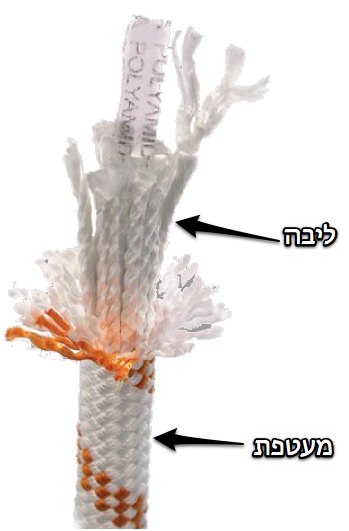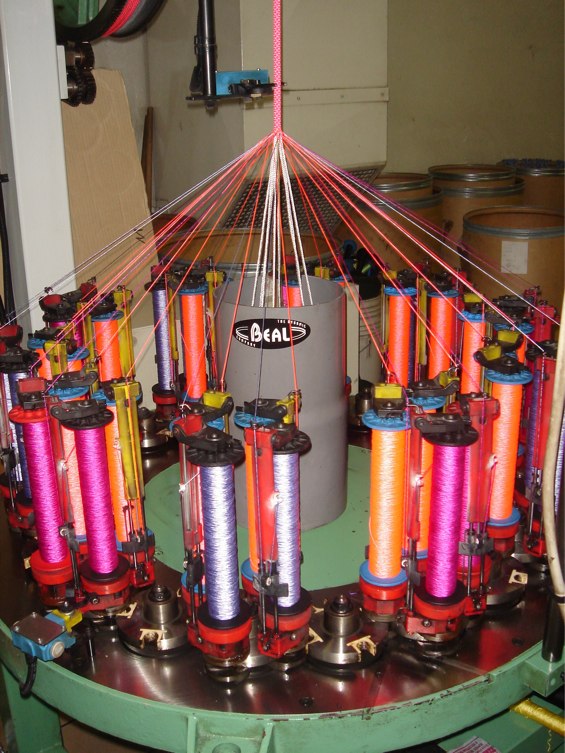הבדלים בין גרסאות בדף "Kernmantle"
(דף חדש: {{LTR}} right|thumb|200px|the inside of a kernmantle rope חבלי ליבה ומעטפת '''Kernmantle ropes''' are rope that ha…) |
|||
| (גרסת ביניים אחת של אותו משתמש אינה מוצגת) | |||
| שורה 1: | שורה 1: | ||
{{LTR}} | {{LTR}} | ||
[[תמונה: kernmantle.jpg|right|thumb|200px|the inside of a kernmantle rope]] | [[תמונה: kernmantle.jpg|right|thumb|200px|the inside of a kernmantle rope]] | ||
| + | |||
[[ליבה ומעטפת|חבלי ליבה ומעטפת]] | [[ליבה ומעטפת|חבלי ליבה ומעטפת]] | ||
| + | |||
'''Kernmantle ropes''' are rope that have two seperate, or almost separate elements: sheath (mantle) and core (kern). The first kernmantle rope was introduced by Edelrid, in 1953. These ropes are widely used for a number of applications, especially in climbing, [[rappelling]], [[caving]] and [[rescue]]. | '''Kernmantle ropes''' are rope that have two seperate, or almost separate elements: sheath (mantle) and core (kern). The first kernmantle rope was introduced by Edelrid, in 1953. These ropes are widely used for a number of applications, especially in climbing, [[rappelling]], [[caving]] and [[rescue]]. | ||
| שורה 22: | שורה 24: | ||
The kernmantle design helps combining traits from both parts in order to achieve the wanted rope charcteristics: elasticity, abrassion resistance, density, knotability etc. | The kernmantle design helps combining traits from both parts in order to achieve the wanted rope charcteristics: elasticity, abrassion resistance, density, knotability etc. | ||
| − | |||
| − | |||
| − | |||
| − | |||
==אריגה ופיתול== | ==אריגה ופיתול== | ||
[[תמונה: rope machine.jpg|right|thumb|200px|A modern machine for making kernmantle rope, in the Beal factory]] | [[תמונה: rope machine.jpg|right|thumb|200px|A modern machine for making kernmantle rope, in the Beal factory]] | ||
| שורה 34: | שורה 32: | ||
---- | ---- | ||
| − | Contributions to this page by: [[user: | + | Contributions to this page by: [[user:Mica Yaniv|Mica Yaniv]], Doron Netzer, Leon Shufutinsky and others... |
| − | |||
| − | |||
| − | |||
[[קטגוריה: general]][[קטגוריה: glossary]][[קטגוריה: gear]][[קטגוריה: mountaineering gear]][[קטגוריה: rock climbing gear]][[קטגוריה: aid gear]][[קטגוריה: climbing]] | [[קטגוריה: general]][[קטגוריה: glossary]][[קטגוריה: gear]][[קטגוריה: mountaineering gear]][[קטגוריה: rock climbing gear]][[קטגוריה: aid gear]][[קטגוריה: climbing]] | ||
גרסה אחרונה מ־23:37, 5 בספטמבר 2009
Kernmantle ropes are rope that have two seperate, or almost separate elements: sheath (mantle) and core (kern). The first kernmantle rope was introduced by Edelrid, in 1953. These ropes are widely used for a number of applications, especially in climbing, rappelling, caving and rescue.
The name comes from German and is constructed from the two words: kern, or kernel, meaning core, and mantel, meaning mantle or sheath.
Modern Kernmantle ropes is made of a large number of very thin filaments. An 11mm static rope, for example consists of some 30,000 fibers. One can calculate that each of these fibers is around 60 microns in diameter (it is a nice exercise, oyu should try it). Most of those filaments (70-80%) are in the core, and the rest are in the sheath, which is tightly woven around the core.
The separation between core and sheath allows a good segregation of the functions they perform. By a choice of fabrication methods, the characteristics of the rope can be fitted for the usage it was meant for.
In most modern ropes, there is a tin nylon band, on which vital rope information can be found: manufacturing year, batch no. etc.
תוכן עניינים
core and sheath roles
core
The main role of the core is to take the load. The core is the main load bearing element in a kernmantle rope.
sheath
The sheath is set to protect the core from abrasion, from dust and sand, and from UV rdiation. In the mountains, when the rope is pulled through ice cristals, the sheath it can rapidly deteriorate, but it protects the core.
rope characteristics
Separaing the core from the sheath enable excelent control over rope characteristics by using different materials, weaving methods and sheath and core density.
materials
Most climbing ropes are made of Nylon. For rescue and other highly abrassive work environment polyesther sheath is sometime used. For canyoning, where float is a significant demand, polypropelene ropes are used.
The kernmantle design helps combining traits from both parts in order to achieve the wanted rope charcteristics: elasticity, abrassion resistance, density, knotability etc.
אריגה ופיתול
הליבה במרבית החבלים מורכבת ממספר עיקרים (משלושה ועד 21), שכל אחד מהם בנוי משנים או שלשה גדילים מלופפים. בגלל הליפוף של הליבה, כאשר מותחים את החבל החבל נוטה להסתובב. זה קורה בעיקר כאשר תלויים על החבל. בעיה זו נפתרה על ידי ליפוף של העיקרים בליבה בשני כיוונים הפוכים. מחצית העיקרים מלופפים בכיוון אחד והמחצית האחרת בכיוון האחר. כיווני הליפוף נקראים כיוון s וכיוון z (ספירלה ימנית וספירלה שמאלית, בהתאמה). כך, חצי העיקרים מנסים להסתובב לכיוון אחד, החצי האחר מנסים לכיוון השני ומתקבל חבל נייטרלי לסיבוב.
בחבלים שזורים, בהם לכל סיב בחבל יש סיכוי טוב להגיע אל המעטפת ולהיפגע משחיקה, בחבלי קרנמנטל רק כ-20% מן הסיבים עלולים לסבול פגיעה כזו. גם אם כל סיבי המעטפת קרועים במקום מסויים (אנחנו אומרים: משהו "הפשיט את המעטפת"), עדיין עומס הקריעה של החבל הוא כ-80% מעומס הקריעה של חבל חדש.
Contributions to this page by: Mica Yaniv, Doron Netzer, Leon Shufutinsky and others...

